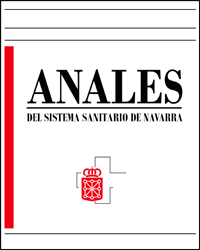Actitudes, autoeficacia e intención hacia la cesación tabáquica en universitarios españoles
DOI:
https://doi.org/10.23938/ASSN.0588Palabras clave:
Estudiantes. Tabaco. Autoeficacia. Actitudes. Intención.Resumen
Fundamento. Conocer las actitudes hacia el tabaco, la percepción de autoeficacia ante el cese y la intención de abandono tabáquico en universitarios fumadores, y su variación según la etapa del proceso de abandono tabáquico.
Material y métodos. Estudio transversal con 255 universitarios (18-24 años) fumadores (≥1 cigarrillo/semana). Instrumentos empleados: entrevista personal, test de Fageström, modelo transteórico de cambio, escala Actitudes, auto-eficacia e intención de abandono tabáquico de los estudiantes y CO en aire espirado.
Resultados. Muestra con mayoría de mujeres (62%), edad media 20,3 años, consumidores de 9,2 cigarrillos/día desde hace 5,7 años, con dependencia leve a la nicotina. El 69% se encontraba en etapas de precontemplación y contemplación. Aunque más del 70% consideró que el tabaquismo es negativo para la salud y el medio ambiente, y el 96,7% presentan actitudes negativas hacia el tabaco, solo el 45,1% era consciente de la morbimortalidad asociada. Más del 60% consideró que el tabaco es un facilitador social, por lo que el nerviosismo (72,6%) y tener amigos fumadores (69,4%) son factores considerados negativos para el abandono tabáquico. El 91% creía que fumaría el próximo año, pero el 86% declaró que no sería fumador en cinco años. El 100% de los sujetos en precontemplación consideraron que fumarán durante el próximo año frente al 83,5% de aquellos en etapa de preparación.
Conclusiones. Los universitarios fumadores muestran actitudes positivas, creencias erróneas y una baja percepción de auto-eficacia ante el cese del hábito tabáquico. En fase de precontemplación todos los estudiantes creen que fumarán el próximo año.
Descargas
Citas
US Department of Health and Human Services. The Health Consequences of Smoking - 50 Years of Progress: A Report of the Surgeon General. Atlanta: GA: US Department of Health and Human Services, Centers for Disease Control and Prevention, National Center for Chronic Disease Prevention and Health Promotion, Office on Smoking and Health; 2014. https://www.surgeongeneral.gov/library/reports/50-years-of-progress/full-report.pdf
PARDAVILA-BELIO MI, GARCÍA-VIVAR C, PIMENTA AM, CANGA-ARMAYOR A, PUEYO-GARRIGUES S, CANGA-ARMAYOR N. Intervention study for smoking cessation in Spanish college students: pragmatic randomized controlled trial. Addiction 2015; 110:1676-1683. https://doi.org/10.1111/add.13009
US Department of Health and Human Services. Preventing tobacco use among youth and young adults: A report of the surgeon general. Atlanta: US Department of Health and Human Services, Centers for Disease Control and Prevention, National Center for Chronic Disease Prevention and Health Promotion, Office on Smoking and Health 2012. https://www.surgeongeneral.gov/library/reports/preventing-youth-tobacco-use/index.html#Full Report
Observatorio español de la droga y las adicciones. Informe 2017. Alcohol, tabaco y drogas ilegales en España. 2017. http://www.pnsd.msssi.gob.es/profesionales/sistemasInformacion/informesEstadisticas/pdf/2017OEDA-INFORME.pdf. Consultado el 15 de mayo de 2018.
MUÑOZ-MUÑOZ E. Prevalencia, actitud, conocimiento del tabaco y terapias de deshabituación en estudiantes de Farmacia en España. Tesis doctoral. Universidad de Granada, 2013.
BERNAT DH, KLEIN EG, FORSTER JL. Smoking initiation during adulthood: a longitudinal study of population-based cohort. J Adolesc Health 2012; 51: 497-502. https://doi.org/10.1016/j.jadohealth.2012.02.017
FLAY BR. Youth tobacco use: risk, patterns, and control. En Orleans, C. T., & Slade, J. Nicotine Addiction: Principles and Management. New York: Oxford University Press 1993; 365-384.
Centers for disease control and prevention. Best Practices for Comprehensive Tobacco Control Programs-2014. Atlanta: U.S. Department of Health and Human Services, Centers for Disease Control and Prevention, National Center for Chronic Disease Prevention and Health Promotion, Office on Smoking and Health 2014. https://www.cdc.gov/tobacco/stateandcommunity/best_practices/pdfs/2014/comprehensive.pdf
ALEGRE M, GUTIÉRREZ A, OLIVÁN V, VARA E, MARTÍNEZ-GONZÁLEZ MA, AGUINAGA I y col. Prevalencia del tabaquismo, conocimiento y valoración de los métodos de cesación tabáquica en estudiantes de medicina. An Sist Sanit Navar 1999; 22: 233-240. https://doi.org/10.23938/ASSN.0499.
PARDAVILA-BELIO MI, CANGA-ARMAYOR A, DUASO MJ, PUEYO-GARRIGUES S, PUEYO-GARRIGUES M, CANGA-ARMAYOR N. Understanding how a smoking cessation intervention changes beliefs, self-efficacy and intention to quit. A secondary analysis of a pragmatic randomized controlled trial. Transl Behav Med 2018. https://doi.org/10.1093/tbm/ibx070
PROCHASKA JO, DICLEMENTE CC. Stages and processes of self- change of smoking: toward an integrative model of change. J Consult Clin Psychol 1983; 51: 390-395. https://doi.org/10.1037/0022-006X.51.3.390
HEATHERSON TF, KOZLOWSKI LT, FRECKER RC, FAGERSTRÖM KL. The Fagerstrom Test for nicotine dependence: a revision of the Fagerström Tolerance Questionnaire. Br J Addict 1991; 86: 1119-1127. https://doi.org/10.1111/j.1360-0443.1991.tb01879.x
Bedfont. Smokerlyzer® Range For use with piCOTM, piCObabyTM and Micro+TM User manual. 2017. https://www.bedfont.com/file/2494-LAB679%20Smokerlyzer%20Manual%20Issue%203.pdf. Consultado 26 de febrero de 2018
FORD KH, DIAMOND PM, KELDER SH, STERLING KL, MCALISTER AL. Validation of scales measuring attitudes, self-efficacy, and intention related to smoking among middle school students. Psychol Addict Behav 2009; 23: 271-278. https://doi.org/10.1037/a0013747
NORIEGA-GARCÍA C, MARTÍN-SANZ N. Psicología social. En: Losada-Delgado ML, editor. Fundamentos de Psicología para Ciencias Sociales y de la Salud. Madrid: Editorial Médica Panamericana, 2014; 295-315.
HOEPPNER BB, BIDWELL LC, COLBY SM, BARNETT NP. Smoking patterns and their relationship to drinking among first-year College students. Nicotine Tob Res 2014; 16: 743-752. https://doi.org/10.1093/ntr/ntt205
ZUZULICH MS. ¿El paso por la Universidad afecta al consumo de tabaco? Horizonte de Enfermería 2008; 19; 29-43. https://doi.org/10.7764/Horiz_Enferm.19.1.29
Publicado
Cómo citar
Número
Sección
Licencia
Derechos de autor 2019 Anales del Sistema Sanitario de Navarra

Esta obra está bajo una licencia internacional Creative Commons Atribución-CompartirIgual 4.0.
La revista Anales del Sistema Sanitario de Navarra es publicada por el Departamento de Salud del Gobierno de Navarra (España), quien conserva los derechos patrimoniales (copyright ) sobre el artículo publicado y favorece y permite la difusión del mismo bajo licencia Creative Commons Reconocimiento-CompartirIgual 4.0 Internacional (CC BY-SA 4.0). Esta licencia permite copiar, usar, difundir, transmitir y exponer públicamente el artículo, siempre que siempre que se cite la autoría y la publicación inicial en Anales del Sistema Sanitario de Navarra, y se distinga la existencia de esta licencia de uso.








